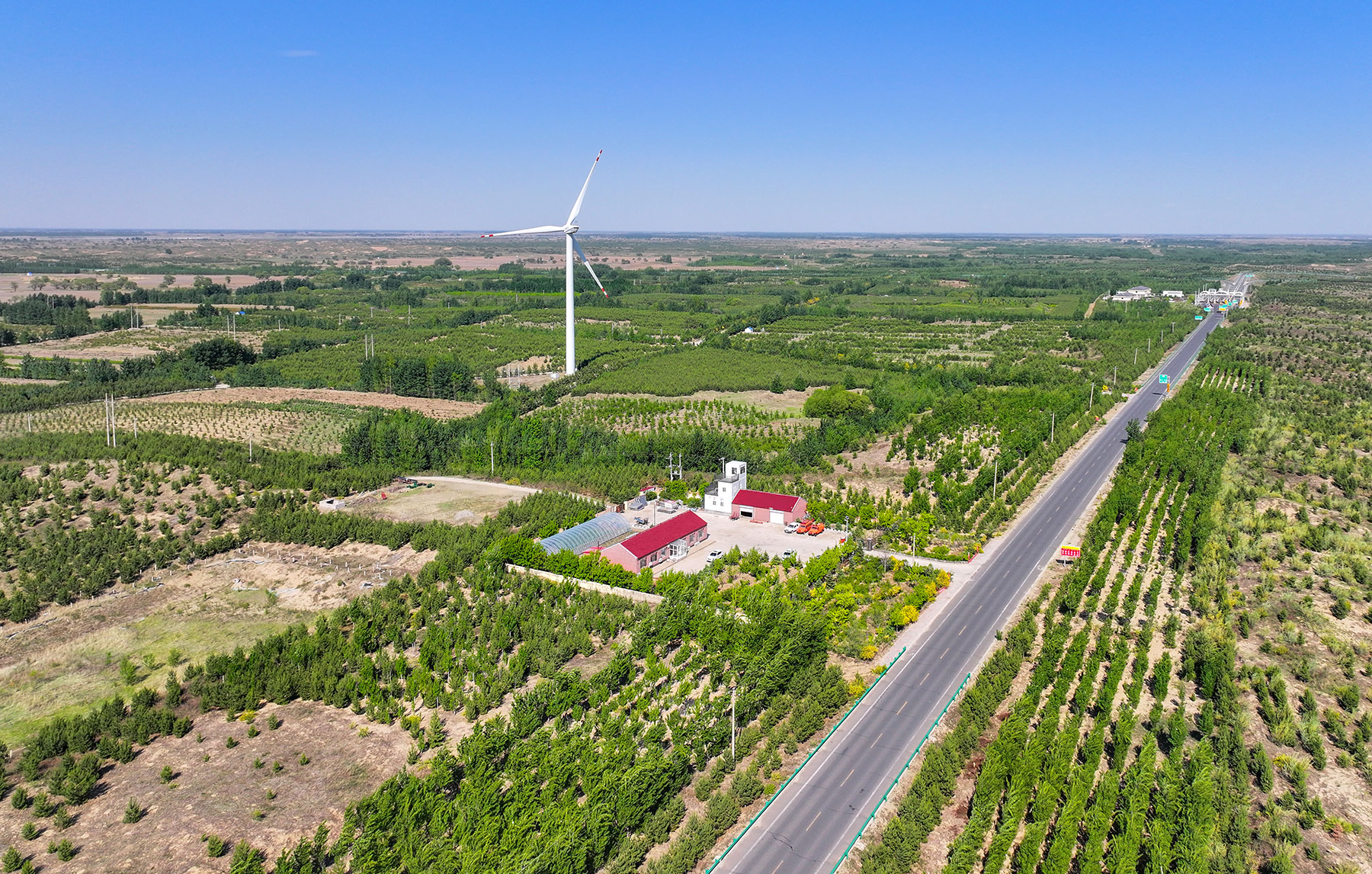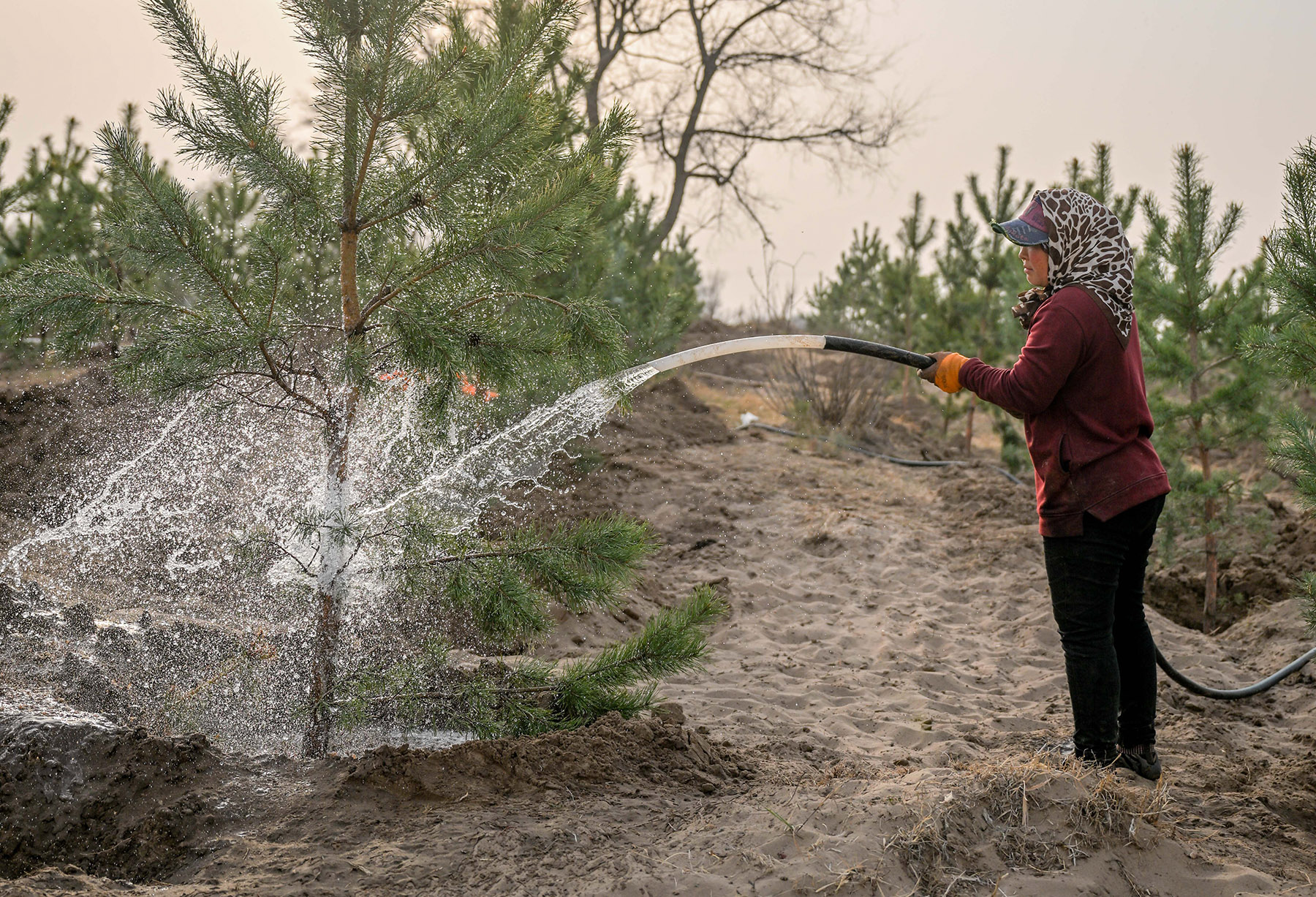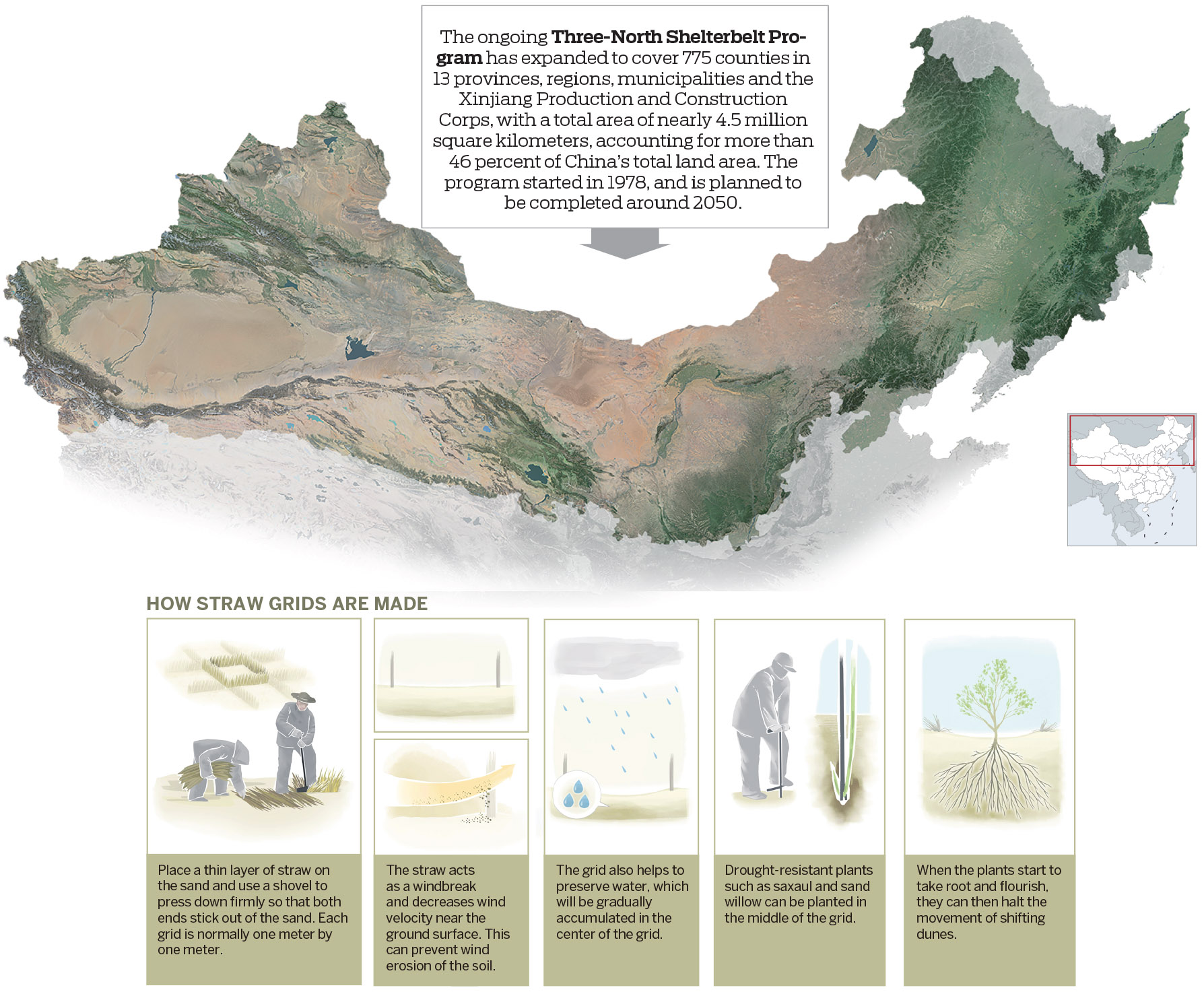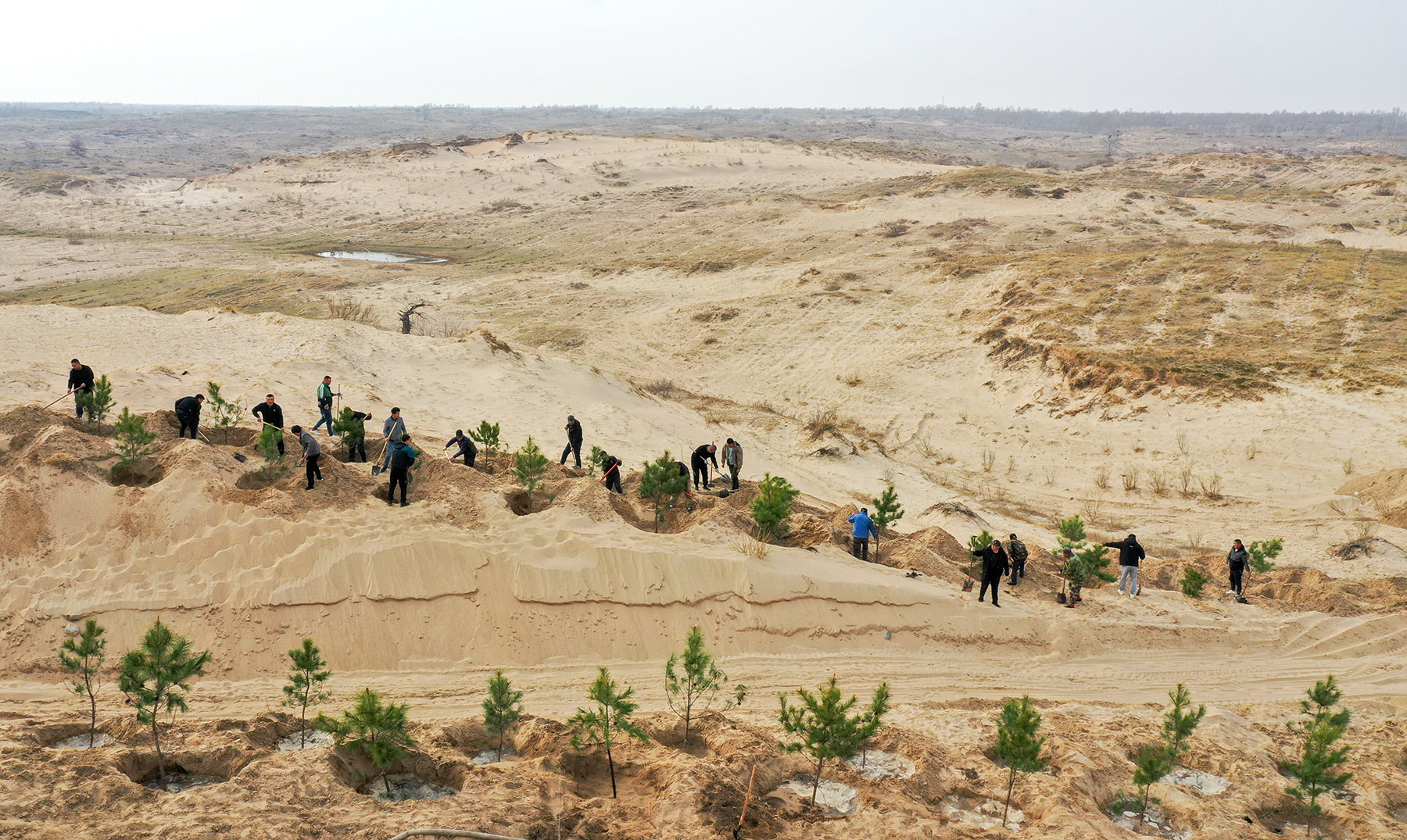The Three-North Shelterbelt Program serves as a vast barrier against the spread of various sandy lands in northern China. China Daily reporters Yan Dongjie and Cui Jia visited the Tengger, Kubuqi and Badain Jaran deserts to witness the efforts and achievements of the megaproject.

Editor's note: As protection of the planet's flora, fauna and resources becomes increasingly important, China Daily is publishing a series of stories to illustrate the country's commitment to safeguarding the natural world.
When thinking about deserts, countries such as Libya and Saudi Arabia come to mind, but China actually has more varieties of deserts than any place on the planet.
With nearly 18 percent of the nation's land mass classified as "desertified" — that's 1.69 million square kilometers — China's 12 major deserts are: The Taklimakan Desert, the Gurbantunggut Desert, the Badain Jaran Desert, the Tengger Desert, the Kumtag Desert, the Qaidam Basin Desert, the Kubuqi Desert, the Ulan Buh Desert, the Mu Us Sandy Land, the Hunshandake Sandy Land, the Horqin Sandy Land and the Hulunbuir Sandy Land.
READ MORE: Desert restored via grassland protection
In addition, stony deserts — barren wastelands that are made of pebble and rocks such as the Gobi Desert — also take up a significant portion of the desertified land.
Covering vast swaths of the northwest, north and northeast of the country, the threat of these deserts and their spread has existed for centuries.
However, several generations of hardworking and dedicated Chinese people have made it their raison d'etre to push back these deserts. They've done this by thinking outside the box, or grid, planting trees and shrubs, and creating a "Green Great Wall" that spreads across 13 provinces and autonomous regions in northern China and protects over 150 million hectares of farmland.

In the 1950s, China was considered one of the "most desertified" countries in the world, with places such as Zhangwu county in Liaoning province in the northeast of the country consisting of 90 percent sandy area.
In 1978, the central government made a significant decision to implement the Three-North Shelterbelt Program across 13 provinces and autonomous regions in northern China to fight against desertification. Over the past 45 years, more than 45 percent of the desertified land has been controlled, 61 percent of the soil erosion area has been managed, and the forest coverage rate has increased from just over 5 percent to 13.84 percent.
On June 6 last year, President Xi Jinping highlighted the period from 2021 to 2030, the sixth phase of the Three-North program, as the key phase for consolidating and expanding achievements in fighting desertification, during a meeting with officials in Bayannuur in the Inner Mongolia autonomous region.
More than ever, desertification control measures are backed by scientific research and the use of the latest technology, said Lu Qi, head of the Three-North program research institute.
"Each desertification control project is now planned based on the conditions and resources of different areas backed by research data. And people have reached a consensus that the goal of desertification control is to ensure that people's lives and development won't be threatened by deserts, which also need to be protected as they are essential parts of the ecological system," said Lu.

Scientific decision-making
"The key to China's success in its path of sand prevention and control lies in scientific decision-making and planning," said Dang Hongzhong, a researcher at the Chinese Academy of Forestry and the Three-North program research institute, adding that the innovative action taken in Zhangwu county in the 1950s was a step forward in sand control.
In 1952, Zhangwu established China's first sand control research institute, with Liu Bin as its director. Liu and other pioneers in sand control decided to introduce the Mongolian Scots pine from the Greater Hinggan Mountains to control sandy areas.
"In traditional thinking, shrubs or grasses should be used to control shifting sandy areas, and planting trees on shifting sand dunes went against the laws of nature. The old experts were not bound by traditional rules, made bold breakthroughs and embarked on an innovative path that no one had expected," said Dang.
Although they had found a drought-resistant tree species, planting trees on shifting sandy land was challenging.
"Zhangwu was eight latitudes away from the original habitat of the Mongolian Scots pine, making the introduction difficult," said Zhang Xueli, deputy director of the Research Institute of Sand Control and Utilization in Liaoning province.

Liu and other sand control pioneers imported Mongolian Scots pine for three years. In the first year, almost all the saplings perished.
"The experts later found that in their original habitat, the Mongolian Scots pine was covered by thick snow in winter, providing insulation and moisture retention.
"However, Zhangwu is very dry in winter and spring, with strong winds, and only two saplings that were accidentally buried by sand survived," Zhang said.
Learning from that experience, researchers covered the next batch of planted pines with sand and soil. Those pine trees survived the winter, growing into the oldest existing forest in the sandy area, known locally as "the autumn of 1955".
As a result, Zhangwu is also known as the "birthplace of scientific sand control in New China". In 1978, the planting of Mongolian Scots pines in sandy areas won national scientific awards and has since been widely promoted in more than 10 provinces and regions, with Mongolian Scots pines becoming a core tree species in the Three-North Shelter Forests of Hebei, Shaanxi and other provinces.
Over the past 70 years, the forest coverage rate in Zhangwu has increased from less than 3 percent to over 30 percent, and more than 8,500 forestry technicians have spread the experience of afforestation and sand fixation to more than 10 provinces, resulting in more than 1 million hectares of forests being planted.

Afforestation and management
In addition to the Mongolian Scots pine, nearly 500 plant species that can be used as windbreaks and for sand fixation have been identified in China's decadeslong sand control practice. The recently published book Common Plants Used in the Three-North Program includes 178 tree species, 177 shrub species and 143 herbaceous plant species.
"After confirming the plant species, the second key to our sand control efforts has been scientific afforestation," said Dang.
Through continuous exploration, sand control pioneers have formulated scientific afforestation plans based on the different natural conditions in various regions.
"Usually, we need to use straw grids for sand fixation, while also introducing shrub species such as Salix gordejevii and Artemisia halodendron to follow up. Only under such protection can the saplings of trees like Mongolian Scots pines survive better," Dang said.
Wang Feng, director of policy and strategic development for combating desertification at the Chinese Academy of Forestry, explained that a straw grid involves inserting discarded wheat straw into the sand, burying half the straw while leaving half above the surface, forming a checkerboard pattern. This method can prevent windblown sand on the surface and help retain water to a certain extent.
"Although the straw grid is not an original sand control method in China, it is the most widely used here. After innovative improvements in terms of area coverage and method, the effect has also been enhanced," Wang said.
In Horqin Left Wing Rear Banner in the Inner Mongolia autonomous region, Wang pointed to a grassland where trees and shrubs grow and said, "Unlike planted forests, this area has naturally regenerated into a sparse woodland grassland landscape, which is a very healthy natural state."

Over the past decade, Wang has visited many sandy areas in Inner Mongolia, Liaoning and other regions, studying how tree density can form the healthiest ecosystem under different environments.
Dang and his team have also spent a considerable amount of time observing whether planting forests will cause a drop in the groundwater level and other sensitive issues related to afforestation.
"After more than 10 years of monitoring, we have concluded that the transpiration of Mongolian Scots pines accounts for approximately 42 percent of the local precipitation annually, reaching close to 60 percent in some years, but it has never exceeded 100 percent," Dang said. "Before, because people did not know how much water this tree species used for growth, some were concerned that it would deplete groundwater. However, scientific monitoring has overturned this conclusion."
ALSO READ: Ecoprotection efforts boost Inner Mongolia
He explained that the Mongolian Scots pine is highly drought-resistant, with over 85 percent of its fine roots concentrated within a depth range of 60 centimeters from the surface, which also means it does not consume a large amount of groundwater.
"One of the most important issues is how to allow the planted trees to naturally reproduce, so that the forests planted by humans for many years can naturally regenerate and continue, ensuring that these 'Green Great Walls' can protect our farmland and cities for generations to come, rather than having to replant them after 100 years," Dang said.


'Photovoltaic Great Wall'
In Ordos, Inner Mongolia, a "photovoltaic Great Wall" running along the greenbelt on the edge of the Kubuqi Desert is taking shape. After its completion in 2030, the "photovoltaic Great Wall" consisting of photovoltaic panels will have an average width of 5 km and stretch for 400 km. That's farther than the distance between London and Paris.
The project, which is only 5 km from the Yellow River, will also act as a wind and sand barrier along the watercourse.
The integration of ecological treatment and energy development is expected to inject new vitality into desertification control, said Du Huiliang, the mayor of Ordos.
Different than regular photovoltaic projects, all the panels installed on this project have been raised more than 3 meters above the ground allowing sanding-binding plants and agricultural products to grow underneath, according to Liu Tianyun, deputy head of the Ordos forestry bureau.
The project, which is expected to achieve an installed capacity of 100 million kilowatts, will also help treat 200,000 hectares of sandy land.
Contact the writers at yandongjie@chinadaily.com.cn


